


















Understanding the specific risks that may affect your local area is important.


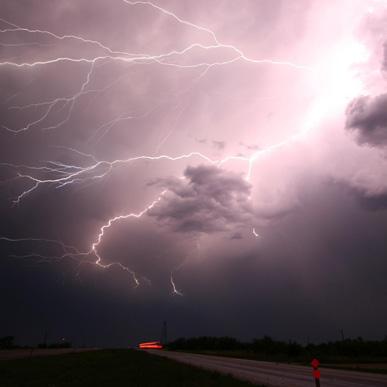

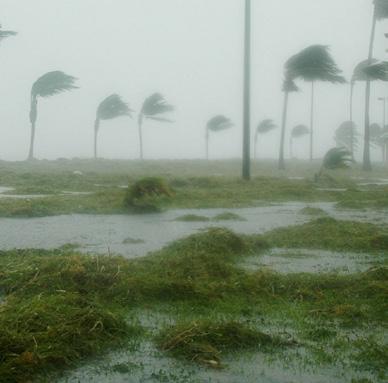
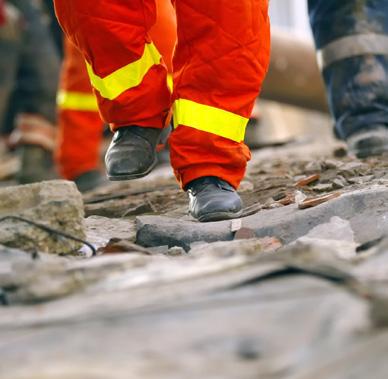
Do you know your bushfire risk or whether your area may flood?

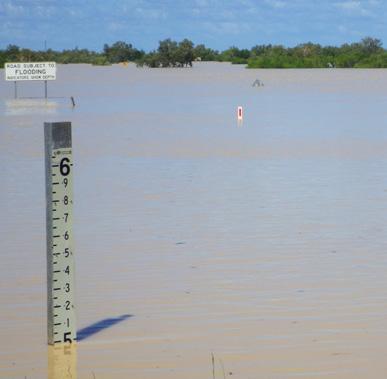
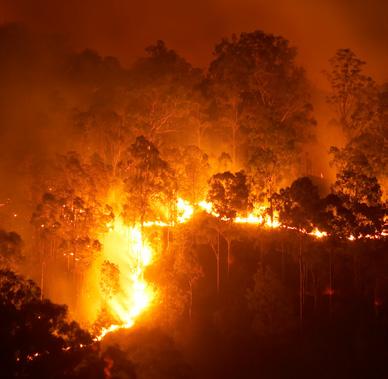
Talk to neighbours and friends about ways to protect your home, which roads are impacted, alternative routes and plan to be self-sufficient for at least three to five days
Ensure that your insurance is current and sufficient to protect your home, contents and business.
Know where to find information and warnings.
Think about your situation and how you would cope without power, access to services and the internet for up to three to five days.
Ensure you have safety switches installed and test them regularly.
If anyone in your house relies on electrical equipment for medical reasons, have a plan if your power is cut – don’t assume it will be restored quickly.
No two disaster events are alike. Be prepared.

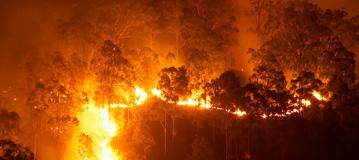
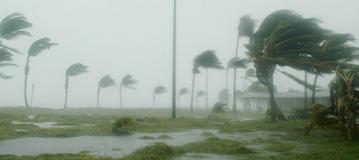
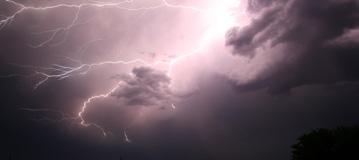

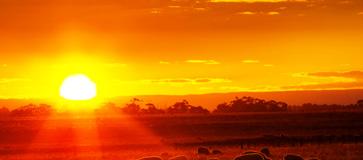
Don’t wait for a disaster to happen before you think about how you and your family are going to survive…
In a major disaster, high winds, fire or rising floodwaters can prevent emergency services from reaching you. Debris and damage can cut road access. Your community and your family could become isolated for up to three days or more.
If you were isolated by a disaster right now, are you prepared? Do you have enough food, water and equipment to sustain your family for three days or more?
The following four simple steps will ensure you and your family are as prepared as possible.
For more information on how to prepare your plans head to getready.qld.gov.au

Preparation for a disaster involves being aware of any potential risks and their impact on your situation, as well as knowing what actions you need to take to ensure all household members and work colleagues are informed.
Use this guide as the first step to learn what disasters impact our region, know your seasons and look at other resources available. Work out which disasters are relevant to your situation (for example your area could be at risk of being inundated by flood or have a history of bushfires). Take note of what is relevant to you to help build your plan.
Develop an emergency contact list and keep it in an obvious position, such as near your phone, to ensure all household members can find and read it. An example of a contact list is included in this guide to start you off.

Identify:
• What may happen during a disaster and discuss possible scenarios.
• What actions you and your family may need to take in the event of each disaster using this guide and other resources.
• Where you might be when an emergency occurs? (Home, work or school).
• How you can stay in contact with family, friends and emergency workers.
• Will you leave early to stay with friends or family or will you stay in place and survive on the supplies you have at home? Keep in mind in some events you may be ordered to evacuate by authorities.
• What preparations you will need to take for your pets?
• Any special needs for infants, medications and mobility.
Develop a Household Emergency Plan, making sure you take into consideration all family members and pets.
For more information on how to prepare your plan head to getready.qld.gov.au.
Our animals are often regarded as part of the family. It is important to remember that you and your family are responsible for the safety of your pets and animals during a disaster.

• Animals are your responsibility, even during disasters and emergencies.
• Your animals must be secured at all times.
Evacuation centres do not cater for animals.
• Have a plan in place for pet evacuation in advance. This might be with relatives, friends, and animal boarding facilities, or to a temporary animal shelter.
• Evacuate animals to a safer location well in advance and away from the emergency zone.
• Practice at least two different evacuation routes with your animals .
• Secure animals inside under shelter or on higher ground before an event.
• Ensure all vacations, stock registers, microchips and council registrations remain current.
1. Food and water for at least five days
2. Medicines with clear instructions, medical records and first aid.
3. Blankets, bedding or nesting material.
4. Favourite toys that bring comfort.
5. Vaccination, registration and current photos of you and your pet.
6. Collar with ID tag, harness or leash.
7. Birds and pocket pets need shelter coverage for their enclosure.
8. Carrier/cage/leash/harness/float/container with a secure lid and air holes to transport animals.
9. Litter tray, litter, waste bags and cleaning products.
10. Contact details for your veterinarian, local animal shelter, local council and alternative animal accommodation facility.
11. Evidence that your pet is a service animal and appropriately trained to access public areas.
12. Consider whether pet insurance is right for you and have relevant paperwork in your emergency kit.
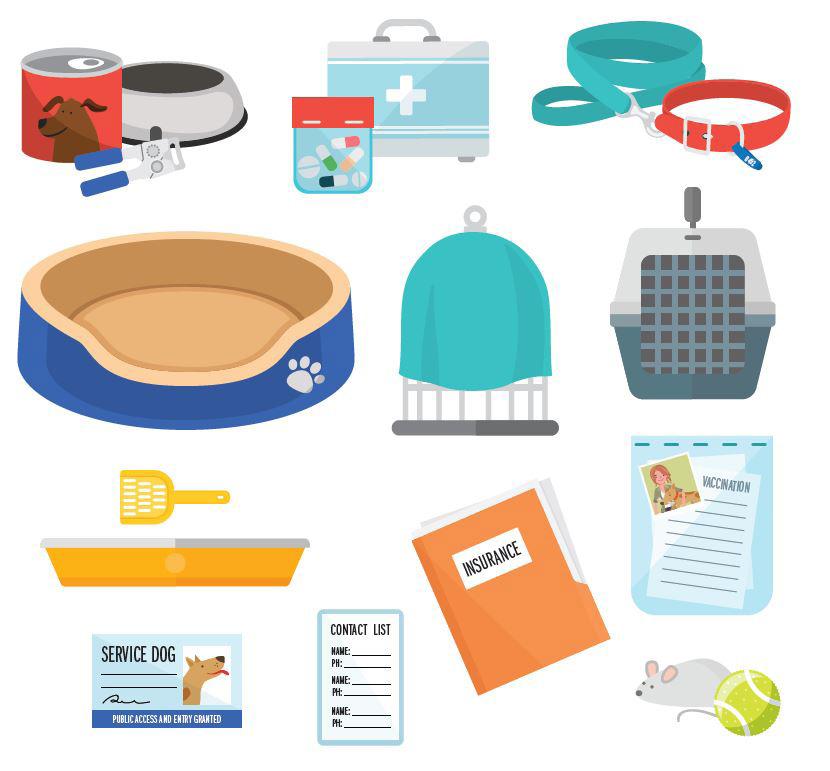
There are two types of kits recommended; an Emergency Kit and an Evacuation Kit
Your Emergency Kit is a collection of items that provides for your household’s essential needs in the event of emergencies like storms, floods and cyclones when taking shelter. An Evacuation Kit is designed to be used when evacuating your home. Your kit should be kept in a sturdy, accessible, easy-to-carry bag, or waterproof box and be stored in a safe place that is accessible.
Prepare kits for each member of your family and label with ID tags. You may not be at home when an emergency strikes so keep additional supplies in your car or at the least some important contact details.

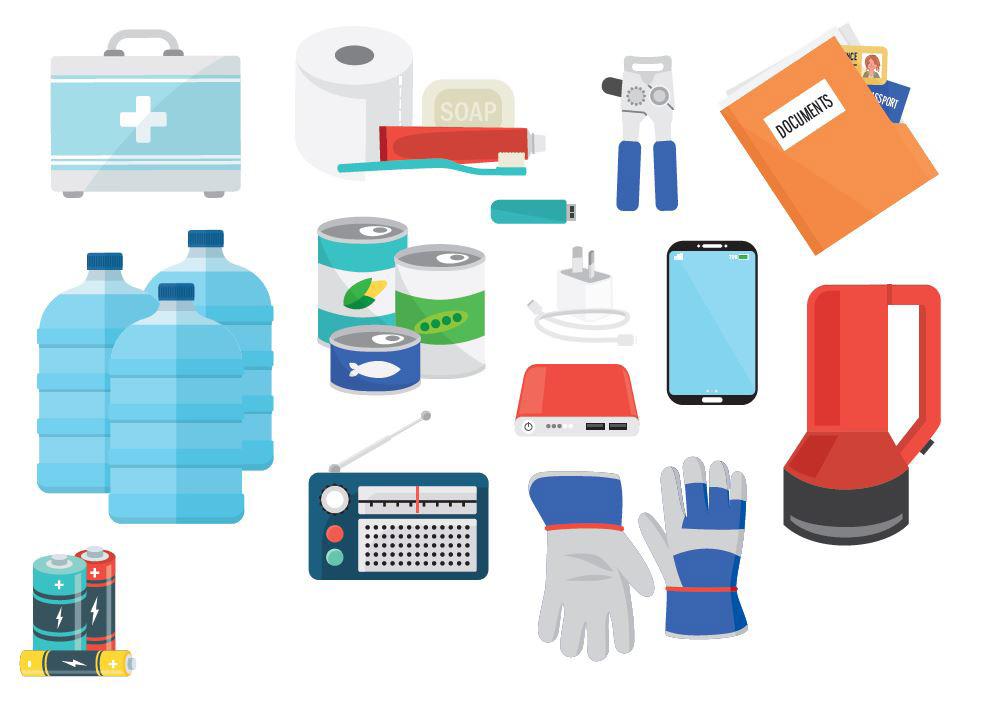
Each kit should have enough supplies to last each family member at least three to four days.
1. Pack 10 litres of drinking water per person at a minimum.
2. A properly equipped first aid kit can save lives.
3. Make sure you include a first aid manual and include a week’s supply of prescription and over the counter medication.
4. Scan and save important documents, contacts, emails and photos to a USB and keep it in your Emergency Kit.
5. A battery powered radio is one of the most reliable items in a disaster, especially during power and internet loss.
6. A pair of sturdy work gloves will help prevent injury and infection when needing to handling rubbish and debris.
The potential need to evacuate where you live might happen at short notice. Preparing an Evacuation Kit now will save you time and be one less thing to stress about in the event of a disaster.
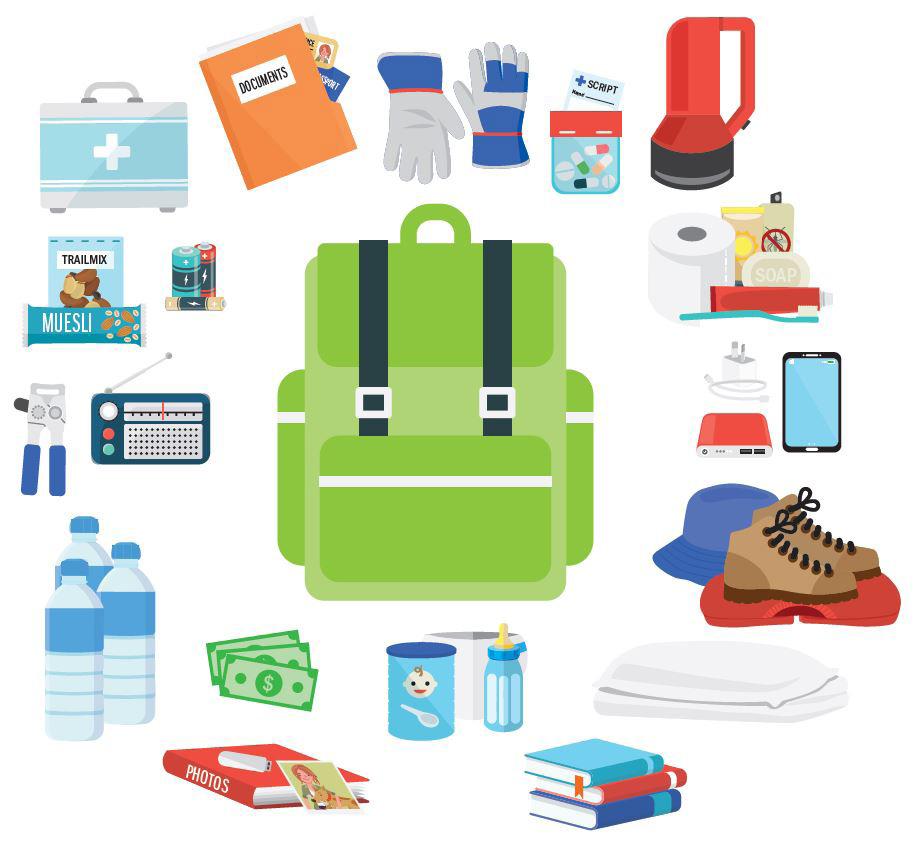

1. Your Evacuation Kit should contain up-to-date copies of important documents, such as your Driver License, insurance policies (home, content, vehicle or life insurance), Passport, legal documents and Birth and Marriage Certificate.
2. Pack some books and games that do not require electricity to help entertain the kids whilst evacuated.
3. Place a reminder on your evacuation checklist to grab valuables, photos (prints and USB/portable electronic storage device) and small mementos – make a list of the specifics of what to grab as it may be hard to think clearly at the time of evacuation.
• Keep your roof in good condition and check it regularly.
• Keep gutters and downpipes clear so water can drain away quickly.
• Trim trees and overhanging branches (be aware of any overhead powerlines).
• Check and fix any corrosion, rotten timber, termite infestations and loose fittings.
• Ensure your home, contents and car insurance is current and adequate. Check your policy includes debris clean up and removal.
• Identify the strongest room to shelter in place during severe storm or cyclone.
• Identify where and how to turn off the main supply for water, power and gas.
• Consider what arrangements need to be made if you have pets and animals.
• Check with your neighbours in case they need assistance.
• Residents and business owners should make their own preparations by purchasing sandbags and sand before flooding occurs. For more information, download the DIY sandbag brochure: www.disaster.qld.gov.au/dmp/sandbagging/documents/Using-Sandbags-to-protect-your-home-andbusiness.pdf
• Store all poisons and garden chemicals well above ground level.

• Identify indoor items you will need to raise or empty if flood threatens.
• Consider alternatives to carpet and relocate powerpoints to well above previous flood levels (using a licensed contractor).
• Arrange for a professional builder to check your building and identify ways you can increase the structural security of your home to withstand high winds or floods.
• Fit windows with shutters or metal screens for added protection during high winds.
• Understand your risk - speak to your local Rural Fire Brigade or Volunteer Community Educator.
• Prepare your Bushfire Survival Plan to ensure access to your property is easy for fire vehicles.
• Remove materials that can help fuel a fire (e.g. long dry grass, dead leaves, branches or debris around your home).
• Check that pumps, generators and water systems are working correctly.
• Disconnect electrical appliances and external television / radio aerials and turn off electricity, solar and gas main supplies if instructed to do so.
• Secure or put away items (e.g. garden furniture) that can be blown around.
• Fill buckets and bath with clean water in case of interruptions to water supply.
• Close windows with shutters or tape windows with strong tape and draw curtains.
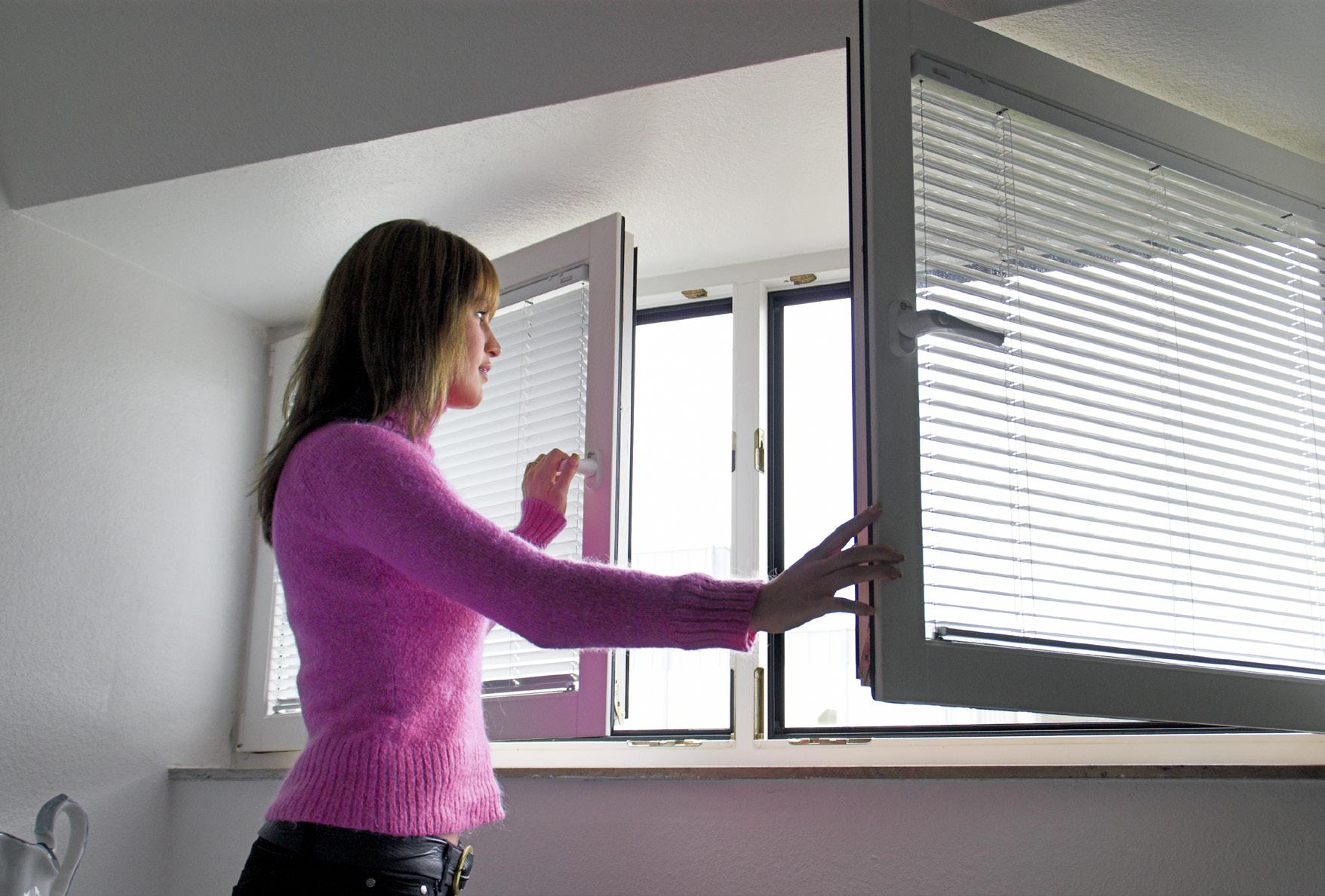
• Disconnect electrical appliances.

• Move outdoor equipment, garbage, chemicals and poisons to a higher location.
• Empty and raise freezers / refrigerators and stack or move furniture, valuables and electrical items off-site.
• Sandbag internal drains and toilets to prevent sewage backflow.
• Move livestock, plant and feed to higher ground.
Finalise preparations
• Secure items around your home



• Activate your Emergency Plan
• Shelter in your home, or
• Commence evacuation to your predetermined safer location.
Tune into your local radio station for emergency information.
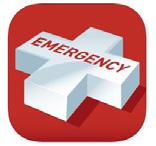

ABC Southern Queensland - 747 AM (Toowoomba)

ABC Brisbane - 612 AM
River949 - 94.9 FM
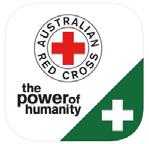
WEBSITES
www.disaster.qld.gov.au www.bom.gov.au www.qfes.qld.gov.au
www.qld.gov.au/alerts www.lockyervalley.qld.gov.au

Lockyer Valley Disaster Dashboard is your one-stop shop for information you may need before, during and after a disaster.


Create a custom home screen icon for your smartphone to keep Council's Disaster Dashboard at your fingertips.

1. Go to the Disaster Dashboard website at disaster.lvrc.qld.gov.au using your smartphone’s default web browser (Safari).
2. Click the share button in the web navigation bar at the bottom of the screen
3. Swipe left across the Bookmarks Bar to show “add to Home screen” option and follow the prompts to add a custom icon
1. Go to the Disaster Dashboard website at disaster.lvrc.qld.gov.au your smartphone’s default web browser.
2. Click the options button at the top right of the screen
. . .
3. Select the “add to Home screen” option and follow the prompts to add a custom icon.
Subscribe to Early Warning Network by clicking on the ‘Receive Free Weather Alerts (EWN)’ on the Disaster Dashboard.
REGISTER, FIND, REUNITE
This service registers, finds and reunites family, friends and loved ones after a disaster. Use ‘Register’ to let people know you are safe. Use ‘Find’ to look for people you know may be affected by an emergency. ‘Reunite’ is a matching process that enables Red Cross, with permission, to share details to connect family, friends and loved ones.
Go to register.redcross.org.au for more information.

During a disaster, you may need to evacuate your home for your safety. If you are advised to evacuate, we encourage you to stay with family or friends away from the disaster area. If you are unable to stay with family or friends, you may be able to stay in temporary short-term accommodation at an evacuation centre.
Your Emergency Plan should include evacuation and shelter considerations based on your circumstances and exposure to risk. Follow these key steps to determine your best sheltering option:

1.
• Consider the location of your home.
• Consider the construction and condition of your home, caravan or temporary dwelling.
• Consider your needs. Do you live alone, have pets or have special needs?
2.
• Shelter in place – If you live in a well-constructed home located outside of the risk zone, your best option may be to shelter in your home.
• Evacuate to shelter in a safer place - Prearrange your evacuation with friends or family first, consider emergency shelter options in your community as a last resort.
Please note: shelters such as places of refuge/emergency shelters and evacuation centres are intended as short term options, have very basic amenities and limited capacity
Evacuate to shelter in a safer place: If you are potentially at risk, your best option is to prearrange your evacuation so you can shelter in a safer place with friends or family. Consider commercial accommodation, evacuation centres or emergency shelter options in your community as a last resort.
• What alternative routes could you use if roads around your home / work / school / office were flooded or blocked?
• Where would you meet your loved ones if you were separated?
• How would you get your children from school or childcare?
• Where you would go if you had to evacuate?
• Ask about emergency evacuation plans at your school, workplace, childcare centre and other organisations.
• Ensure all household members know where, how and when to turn off the power, water and gas supplies in case of evacuation.
• Know where the power lines are on your property so you can ensure you avoid them if you have to evacuate.
If you are planning for a possible evacuation and time permits, there may be some extra precautionary measures you can take.
You can follow the 'shutdown procedure' when leaving your house. This should be marked on your inverter or meter box. A general guide to the procedure is as follows:
• Turn off the solar supply mains switch (this is usually found in the meter box)
• Turn off the normal supply main switch (this is usually found in the meter box)
• Turn off the PV array isolator (this is usually found next to the inverter)
Some stand-alone solar power systems may include battery storage that can also be disconnected. You can take the following steps to shut down your stand-alone solar system and battery storage:
• Turn off the solar array
• Turn off the inverter
• Follow the battery shutdown procedures to isolate the battery bank
• Disable the generator from starting if it has auto start.
1. Ensure you turn off power, gas and water and that your property is locked and secure.

2. Notify a family member or friend outside of the threat area that you have evacuated and where you are going. Get this person to advise other family and friends.
3. Make and enact your animal evacuation plan for your pets and animals.
4. Remember to take your emergency kit with you.
Seeking refuge in an evacuation centre should be considered as a last resort.
Severe thunderstorms can produce large hail, damaging wind, lightning and heavy rainfall, which can cause death, injury and damage to property. Damaging winds and heavy rainfall can also be produced in other weather systems, such as in a monsoon or an East Coast Low, which can cause extensive damage to property and turn debris into dangerous missiles. The Bureau of Meteorology (BOM) issues Severe Thunderstorm and Weather Warnings for these phenomena.

Pay close attention to weather forecasts and warnings at any time of year but particularly during storm season - this information will assist you in daily preparations around the home. Radio news weather bulletins will usually provide the most information on current conditions and the latest warnings that have been issued or visit the Disaster Dashboard or check BOM for warnings.
IF WEATHER CONDITIONS INDICATE THE POSSIBILITY OF STORMS, MAKE SURE YOU’VE COMPLETED THE FOLLOWING PRECAUTIONS:
• Your Emergency Plan is up-to-date and all householders know what to do in case of a severe storm
• Your Emergency Kit is fully stocked
• Your insurance is up-to-date and covers damage to home and contents in case of severe storm
• Your yard and outdoor areas are free from loose items like patio furniture, garden tools and rubbish
• You have trimmed any overhanging branches, cleaned gutters and ensured rooves and gutters are in good condition
• Move vehicles under shelter or cover with firmly tied tarpaulins/blankets.
WHEN YOU HEAR A SEVERE STORM WARNING:
• Stay tuned into warnings
• Contact family to make sure everyone is aware of the warning
• Shelter and secure animals
• Secure outdoor furniture and gardening items
• Park vehicles under shelter or cover with firmly tied tarpaulins/blankets
• Disconnect all electrical items, aerials and computer modems.
DURING A SEVERE STORM:
• Stay tuned into warnings via battery powered radio
• Activate your Emergency Plan
• Stay inside and shelter well clear of windows, doors and skylights
• If the building starts to break up, shelter in the strongest part of your house (cellar, internal
• Room, hallway or built-in wardrobe) under a mattress or strong table or bench.
• If outdoors, seek solid enclosed shelter
• If driving, stop clear of trees, power lines and streams.
Severe thunderstorms can produce flash flooding.

Flash flooding is the most dangerous in terms of potential threat to loss of life and can result from relatively short, intense bursts of rainfall. People are often swept away after they enter these floodwaters on foot, or in vehicles, due to the speed and power of the swift moving water.
There may be little or no advance warning for a flash flood so it is important to:
• Pay attention to weather patterns and weather forecasts
• Stay away from rivers, creeks and drains
• Get to higher ground
• Act quickly
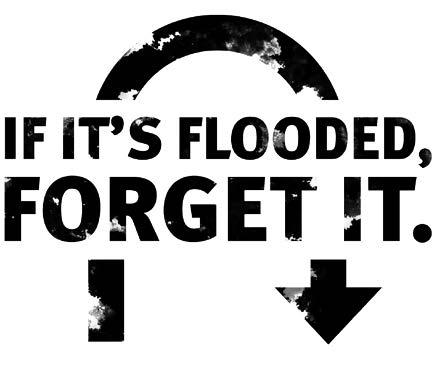
• Never try to drive, ride or walk through a flash flood – if it’s flooded, forget it.
Mountain or coastal rivers quick onset flooding occurs in the mountain headwater areas of large rivers, as well as in rivers that drain to the coast. In these areas, the rivers are steeper and flow quicker, with flooding lasting for one or two days. These floods can pose a risk to loss of life and property as there is much less time to prepare and the flow of water is faster and more dangerous.
Inland rivers slow onset flooding is the flooding of rivers in the vast flat areas of central and western Queensland that may last for one or more weeks and can lead to:
• Major loss of livestock and crop damage
• Extensive damage to rural towns and road and rail links
• Isolation of whole communities for weeks and sometimes months.
Never go around or remove road signage. Bridges and floodways must be inspected for safety before reopening.
• Activate your Emergency Plan
• Stay tuned into warnings and updates
• Move vehicles, outdoor equipment, garbage, chemicals and poisons to higher locations
• Sandbag indoor drains to prevent sewage back-flow
• Plan which indoor items you will raise or empty if water threatens your home
• Check your Emergency Kit is fully stocked.
If you need to evacuate due to the expected arrival of floodwater, follow the evacuation tips included in your Emergency Plan and travel to your predetermined safer location.
Emergency services receive many calls every year for assistance to people who have ignored traffic signs and road closures and become stranded in flood waters. This is extremely dangerous behaviour and also puts the lives of rescue personnel at risk. Think about the consequences of your actions and don’t risk your life or the lives of others. Don’t drive through flood water. Children may think playing in flood water is fun but it is very dangerous. In Queensland, many young lives have been lost from children playing in and around floodwater. Warn children of these dangers and to keep away from floodwater.
A bushfire could be closer than you think. Prepare your home, property and family now and have your Bushfire Survival Plan in place before bushfire strikes

An unprepared property is not only at risk itself but may also present an increased danger for neighbours.
Will
If you plan to leave early then you must leave your home well before a bushfire threatens and travelling by road becomes hazardous.
Will you stay?
Preparation is the key to survival; you will need to be mentally and physically ready and have a plan.
Don’t assume you will receive a warning as a fire approaches.
Every year bushfires put the lives and properties of Queenslanders at risk. Everyone has a part to play in bushfire mitigation and it is vitally important that we all take steps to ensure we prepare for bushfires.
• Do you live within a few kilometres of bushland?
• Does your local area have a bushfire history?
• Is your home built on a slope?
• Do you have trees and shrubs within 20m of your house?
• Is your ‘Bushfire Survival Plan’ more than one year old?
If you answered ‘Yes’ to one or more of these questions you may be at risk in the event of a bushfire. Visit www.ruralfire.qld gov.au and develop a Bushfire Survival Plan.
You don’t have to live in the bush to be threatened by bushfire, just close enough to be affected by burning material, embers, and smoke.
Preparing and planning for bushfire is essential to your survival in a bushfire – people who plan and prepare for bushfires are more likely to survive than those that do not.
• Prepare your Bushfire Survival Plan (BSP) – Ask your local Rural Fire Brigade, or Volunteer Community Educator, for help.
• Decide NOW if you will prepare and leave or prepare and stay.
• Share your plans with your family and friends.
• Check your local Fire Danger Rating on www.ruralfire.qld.gov.au regularly and understand the current fire risks.
Properties that are well prepared are far more likely to survive a bushfire, so everyone living in a bushfire prone area should prepare their property:
1. Clear space around buildings.
2. Clear and remove undergrowth.
3. Fill any gaps in the eaves and around windows and door frames.
4. Clear debris and grass from fence lines.
5. Remove any fire hazards from around the house.
6. Reduce debris in and around your property e.g. remove fallen palm fronds and piles of grass clippings, rake up bark and maintain your yard.
7. Make sure you have appropriate water and firefighting equipment.
8. Make sure your property has cleared access for fire trucks.
TAKE ACTION TO SAVE YOUR LIFE.
• Report bushfire activity to triple zero (000)
• Refer to your prepared Bushfire Survival Plan
Please note: It is illegal to dump green waste over your fence line, including dumping on public land, parks, bushland and creeks. This activity can increase fuel for fires and put your property at risk.
• If you are going to prepare and leave notify your family and friends that you are leaving and tell them where you are going.
• If you are going to prepare and stay, follow the plans you have made in your Bushfire Survival Plan to prepare your home and notify your family and friends that you are staying.
• “Tune in” to the Bushfire Warnings and messages on www.qfes.qld.gov.au, QFES on social media and listen to your local radio.
SURVIVE
• Don’t return to your home until it is safe.
• Remember to look out for dangers as you return home including:
• Emergency crews working around the area.
• Animals not behaving normally.
• Trees that may have been weakened by the fire and can fall at any time.
• Power lines that have come down or may fall and expose you.
• Water and other infrastructure which may not be working.
For more information, visit www.ruralfire.qld.gov.au or read other PREPARE.ACT.SURVIVE. resources.
STAYED
• Stay inside your home until the fire has passed.
• Keep hydrated.
• Check around your home for any possible embers.
• Check on everyone in your home and make sure they are okay.
• Keep tuned into the bushfire warnings and information.
• Check around the outside of your house for spot fires when the immediate danger has passed.

• Drink plenty of water.
• Stay at your home until it is safe.
• Stay “tuned in” for bushfire warnings and messages.
A heat wave is an extended period of very high summer temperatures with the potential to adversely affect communities.
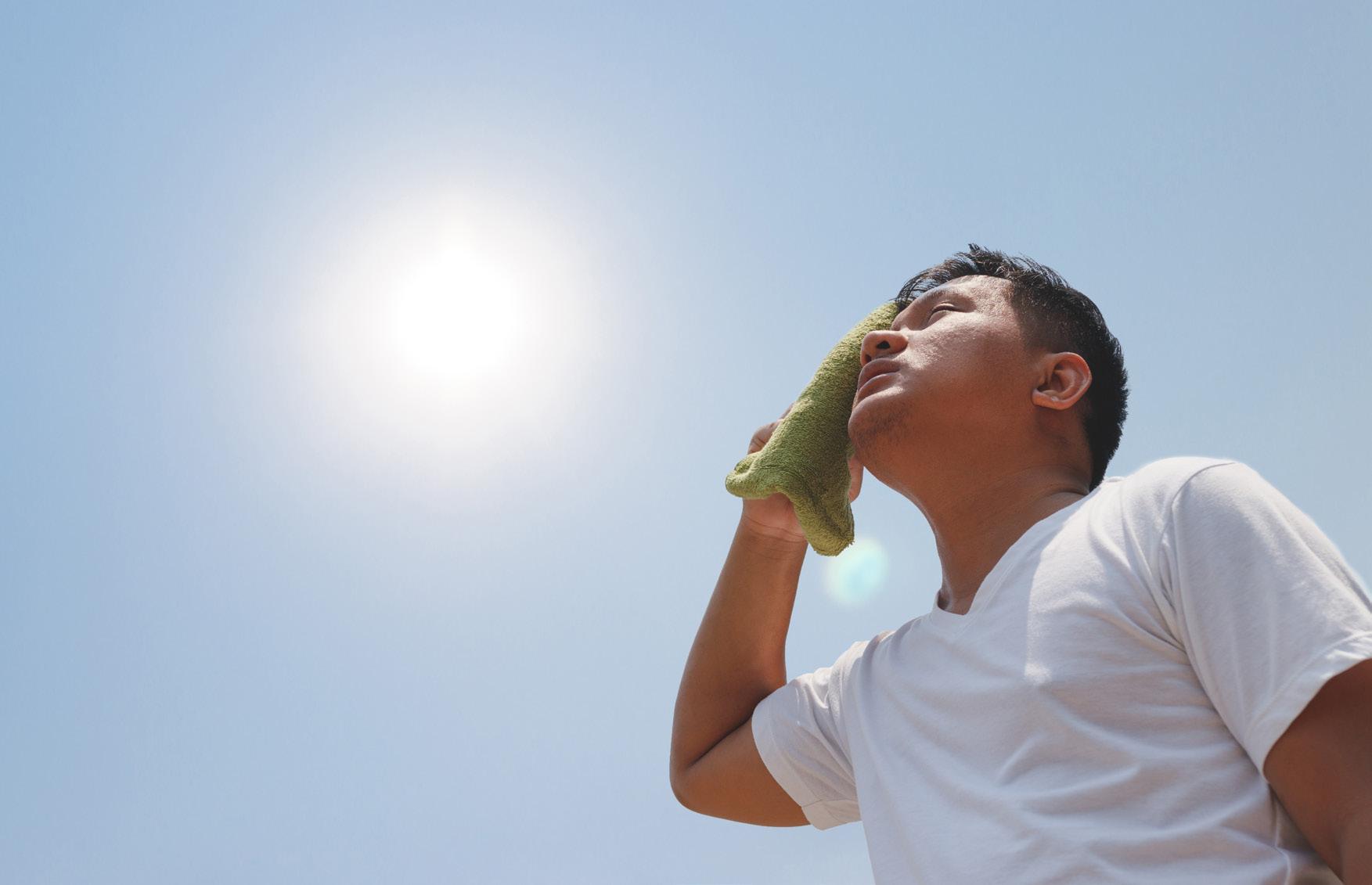

1. Stay hydrated and nourished
2. Stay cool Stay connected
3. Drink plenty of water often to avoid dehydration.
4. Avoid drinks with alcohol, caffeine and high sugar.
5. Eat small meals more often.
6. Keep your body cool.
7. Find a cool shady spot and avoid hot, closed spaces.
8. Wear light, loose cotton clothes.
9. Stay out of the sun from 10 am to 3 pm.
10. Slow down and take it easy. Avoid strenuous activities.
For more information, visit www.health.qld.gov.au/ disaster/heat/heat-wave.asp
Tropical cyclones are intense low-pressure systems that form over warm tropical waters. Winds in a cyclone travel in a clockwise direction around the centre and can reach speeds over 200 km/h. The severe winds can extend for hundreds of kilometers from the calm ‘eye’ or centre of the cyclone.

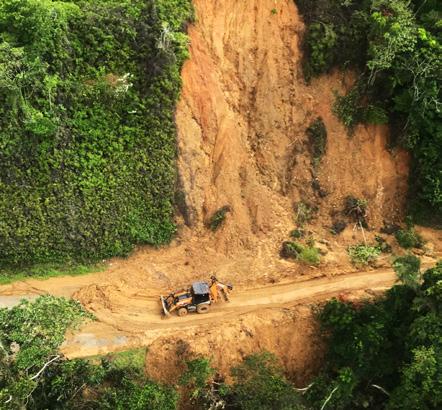
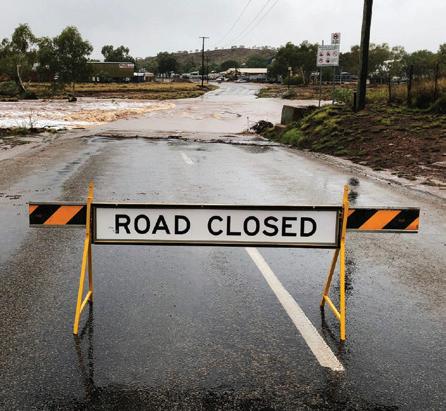
Cyclones are dangerous because they produce destructive winds, heavy rainfall and damaging storm surges. The destructive winds can cause extensive damage and can turn debris into dangerous missiles. The heavy rainfall associated with cyclones can produce extensive flooding and landslides which can increase the risk of drowning and cut road access.
Storm surge is generated by the low atmospheric pressure and gale force onshore winds experienced during a tropical cyclone. As a cyclone approaches the coast, this mound of seawater is pushed onto shore and can appear as a rapid rise in sea level, up to several metres high, at least 50 km wide and can last up to several hours.
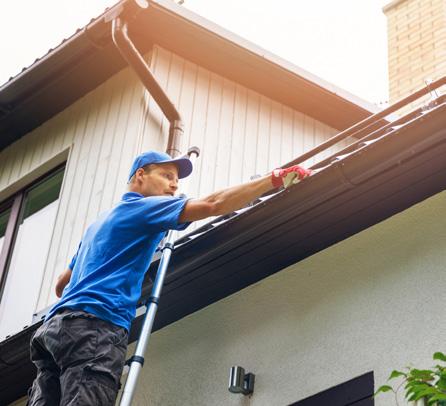

The combination of storm surge and normal ocean tide is known as a ‘storm tide’. The worst impacts can occur when a storm surge arrives on top of a high tide. When this happens, the storm tide can reach areas that might otherwise have been safe. If you live in a low-lying tropical or sub-tropical coastal area, you could be at risk from storm tide inundation.
Even though our region does not get the initial impact of a cyclone often, we do experience the flow on affect as the system moves through the region bringing strong winds and rain which may cause flash flooding in some areas.
A landslide is the movement of a mass of rock, debris or earth down a slope. Landslides can vary in size from a single boulder in a rock fall to tens of millions of cubic metres of material in an avalanche. Landslides can be caused by a saturation of slope material from rainfall or seepage, vibrations caused by earthquakes, waves undercutting cliffs or by human activity.
Consider whether you are in an ‘at risk’ area:
• Are you near a steep slope?
• What is the structural integrity of your home?
• Is your home located in a cut and fill site?
• Have an action plan in your home that all household members are aware of.
Stay alert to changes in the weather, particularly high amounts of rainfall in the area. Be aware of the following signs:
• Changes to the typical landscape, for example, storm water drainage deviating from the normal path, progressively leaning tree or small slides.
• Doors and windows jamming.
• New cracks, pulling away or widening of existing cracks appearing in the property, for example in concrete paths, retaining walls, foundations and walls.
• Exposure of underground systems such as phone lines and water pipes.
• Unusual sounds such as trees cracking, water trickling or falling mud and debris.
• Collapsed pavement, mud, fallen rocks and other debris flow.

If you notice any signs of a landslide occurring, move quickly out of the path of the flow. Save yourself and don’t worry about your belongings. The mud and debris can flow quickly and with great force that can swallow a vehicle in its path. Get away from the area as soon as possible and stay clear as it will be unstable and further slides could happen. If you cannot escape, curl up into a tight ball and protect your head.
For more information on what to do before, during and after disasters, visit the Emergency Management Australia website.
Earthquakes are a shaking or trembling of the Earth’s crust caused by the release of huge stresses due to underground volcanic forces, the breaking of rock beneath the surface, or by sudden movement along an existing fault line. Most earthquake casualties result from falling objects or debris when shocks damage or demolish buildings and other structures. Other dangers are landslides, ground displacement (faulting), subsidence and tsunamis. Electricity and telephone lines, as well as gas, sewer and water mains can also be damaged.

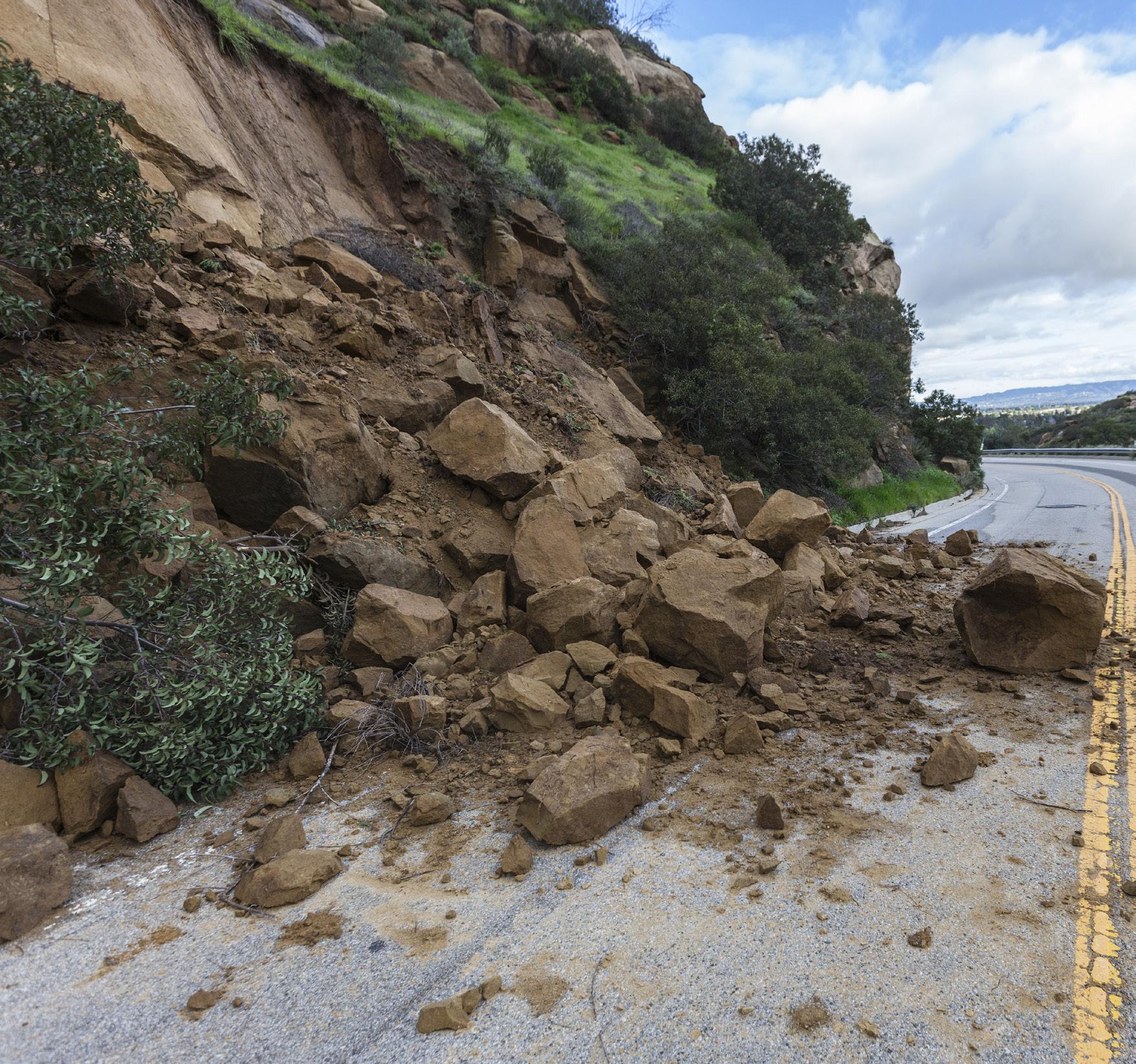
The State Emergency Service (SES) is a volunteer organisation designed to help the Queensland community in times of emergencies and disasters.
Each year the SES receive thousands of calls for assistance. The SES is involved in preparing for, and responding to, many different types of disasters and emergencies including:

• Cyclones
• Storms
• Floods
• Crime scene/forensics searches
• Public events
• Body recovery
• Earthquakes
• Cliff rescues
• Transportation incidents (road/rail/air)
• Landslides
• Searches for missing persons, and
• Animal disease outbreaks.
• Search and rescue
• Help injured persons
• Protect persons or property from danger or potential danger associated with an emergency, and
• Other activities to help communities prepare for, respond to and recover from disaster events.
SES volunteers have limited resources to respond to emergencies. Please ensure that your situation is an emergency before you call. You can call the SES for the following assistance during emergencies:
• Trees and branches down and access to your home is blocked
• Major flooding and temporary repairs/covering of damaged or leaking roof
• Access to tarpaulins for homes
• Information on where to access sandbags.
The SES is not available to undertake general maintenance on leaking roofs or cleaning blocked gutters during rain or cyclone events. If you rent your property please contact the property owner or manager for maintenance issues. This should be done prior to the wet season.
The SES must have the owner’s permission to enter a property or access a roof. Power must be turned off before SES access a roof. You will need to have a licensed electrician or Energex turn it back on.
Only call 132 500 for flood or storm emergency assistance during a weather event. The SES are volunteers and they will respond as soon as possible, however if at any time your situation becomes life threatening, call Triple Zero (000) immediately.
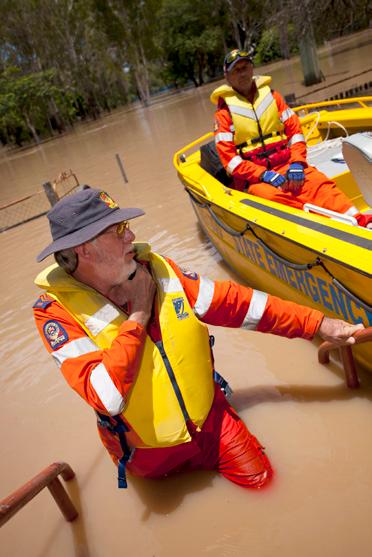
Before you call 132 500 can you help yourself? Place a bucket under a leak, reposition furniture, internally tarp over furniture. In a large scale event the SES will be overwhelmed with jobs and may not be able to get to you for hours or days.
Alternatively you can lodge a request for SES assistance via www.132500.qld.gov.au or by downloading the SES Assistance QLD App.

SES will provide tarps for your roof to temporarily protect your house from the elements. To secure a tarp to a tie-off point use a round turn and two half hitches knot. This simple knot keeps the tension on the tarping rope whilst being tied. Make sure there is firm tension on the tarping rope but not so tight that you risk pulling the eyelets out of the tarp.
For more information, download the tarp retensioning brochure: www.emergency.qld.gov.au/ses/about/pdf/SES-Tarp-Retensioning-Insert.pdf.
Helping yourself, your family, your neighbours and/or vulnerable people within the community
Keeping your gardens and trees maintained
Keeping your gutters clear
Be Prepared
Listen to instructions and warnings
Keep an emergency kit
Ensure you have clear drainage around your house
Have tarps ready for internal use
Have sandbags, plastic and sand ready to sandbag your doors.
SES members are helping you while their properties are being impacted too.
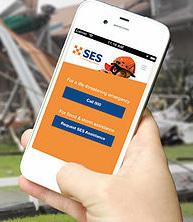


In most cases people will want to return to their homes as soon as possible after a disaster and undertake repairs to their home, but for your safety you should wait until hazards have been cleared, basic needs are available and the site is declared safe. Make sure you wear protective clothing when cleaning up and take the necessary precautions.
The Queensland Building and Construction Commission website www.qbcc.qld.gov.au provides additional information including:
• The Natural Disaster Repairs Contract is designed to help you organise repairs to a home, duplex or home unit after a natural disaster (e.g. a flood, severe storm or cyclone, etc).
• If you have been involved in a natural disaster such as a flood, bushfire, cyclone or severe storm, QBCC assists Queensland communities recover from natural disasters by providing technical and general advice on a wide range of rebuilding issues.
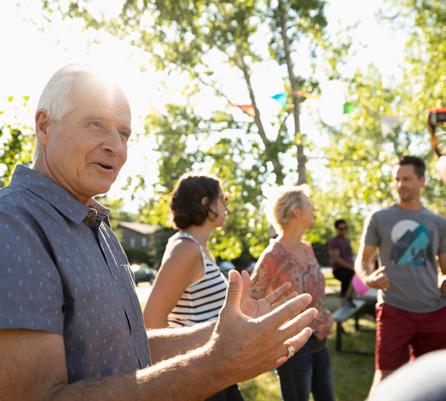



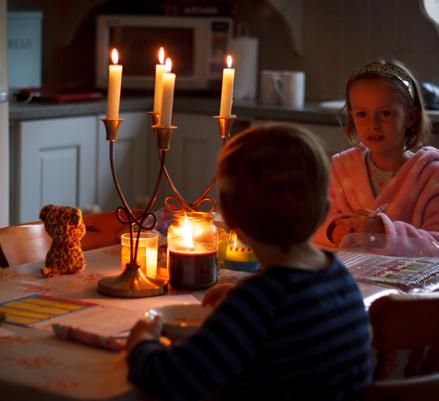
A solar system that may have been damaged in a flood, storm or bushfire needs to inspected by an accredited installer to ensure it is not dangerous.
Do not attempt to turn on the system after a storm or flood. Take care with solar equipment or structures which may have fire damage. Stay away from the solar panels and wiring until assessed as safe to approach.
Even if the network supply is turned off, solar systems and associated wiring may still be live; systems will continue to produce voltage during the day.
Ensure that any repairs to the system are electrically safe before it is recommissioned. This check needs to be done before other clean-up work starts around the modules and associated electrical wiring.
While there are various types of insurance, the most common are:
• Home building;
• Home contents; and
• Motor vehicle insurance.
Areas within an insurance policy to pay particular attention to:
• Level of cover; and
• Excess amounts.
The following tips provide a useful guide for what people can do to assist when making an insurance claim.
• Know who you are insured with and keep their contact details in a safe place.
• Contact your insurance company as soon as possible after the event to register your intention to claim and seek advice about the claims process.
• If your home or business property is damaged, make temporary repairs only to prevent further damage. Take photos of the damage before you start repairs.
• If your assets (furniture, clothing, or carpets) have been damaged, remove them as part of a general clean-up. If possible they should be kept in a safe location so they can be inspected as part of the claims process if necessary.
Additional information is available at www.understandinsurance.com.au.
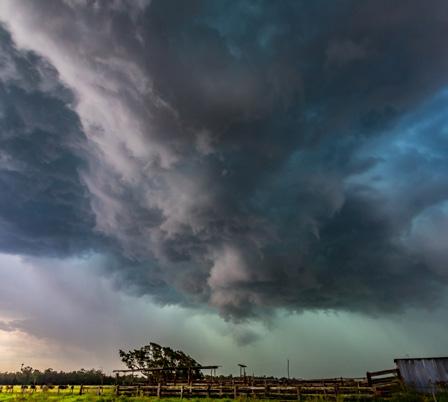
If you want to help an affected community, donating money through an official charity is the best option. This allows the people affected by the disaster to make choices about what is best for them to help their recovery. This also puts money back into the local economy which assists early recovery for the whole community.

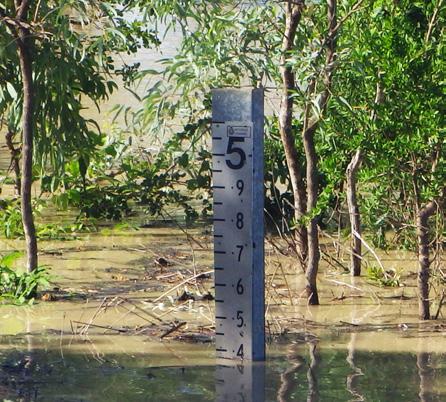
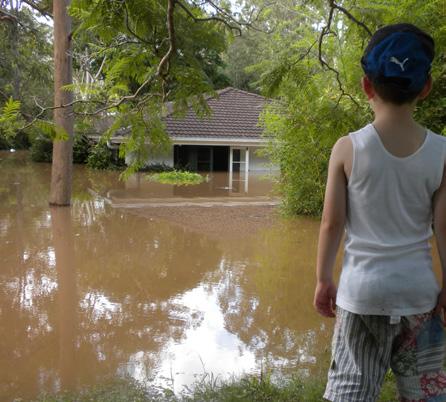
Disasters like fires and floods, stir up enormous public sympathy—we all want to help those affected. Often we think to help by donating our second-hand clothing and goods. But, what many of us don’t (continue on page 30)
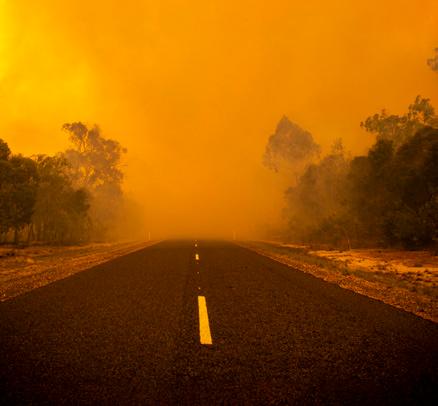
realise is that these types of donations rarely provide the benefits we assume they will for disaster affected communities.
Research clearly shows that, rather than helping, such donations create significant extra work for authorities and can actually distract recovery efforts and undermine community resilience. Dealing with unsolicited donated goods takes time and focus away from the very important work that needs to be done with disaster affected people.
Large quantities of donated goods in a disaster affected location can also seriously depress the sales of local businesses and delay recovery of the economy. In addition, donated goods can impose a sense of obligation on survivors who may be struggling to deal with what has happened. This sense of obligation is difficult to reconcile when the goods are unneeded or of poor quality.
However, public care and support is very important to disaster affected people. It helps them feel more positive and confident about the task that lies ahead.
The most effective way we can all help is by contributing money. Donating money is always the best option because it is more flexible, provides choice, promotes self-directed recovery and more accurately targets need. It also stimulates local economies.
During a disaster, authorities quickly assess what is needed and targeted appeals may be launched for particular items. We can all help significantly by waiting for those appeals and only offering good quality items that are requested.

If you want to help an affected community, go to www.givit.org.au to see what is needed or to donate.
Before and after extreme weather, when it’s safe to do so, members of the community can get involved in preparation and recovery activities that support disaster agencies, government, non-government organisations and community groups through Volunteering Queensland’s Emergency Volunteering CREW (Community Response to Extreme Weather).
It’s for those who are keen to help their fellow Queenslanders during their time of need. By registering your location, skills and availability they can contact you if your help is needed.
The Emergency Volunteering CREW team have referred more than 30,000 volunteers across Queensland and have helped shape community recovery and reduce the impact of disasters by including the widespread support of volunteers in a safe and considered way. Find out more and register at www.emergencyvolunteering.com.au.
Birth, death, marriage and change of name certificates 1300 366 430 Medicare Card 132 011
Driver Licence 13 QGOV (13 74 68) Property title 13 QGOV (13 74 68) Tenancy agreement 1300 744 263 Taxation documents 13 28 61
Passport 131 232 Immigration Visa 131 881 Outstanding fines 1300 365 635 Family law documents 1300 352 000 Occupational licensing and organisation registration 13 QGOV (13 74 68)
Not-for-profit organisations that provide post-disaster emotional support, crisis hotlines and other assistance to the community are listed below:
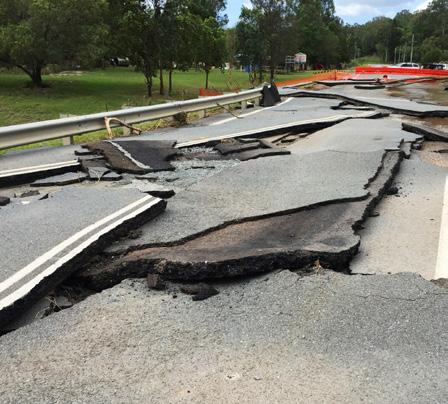
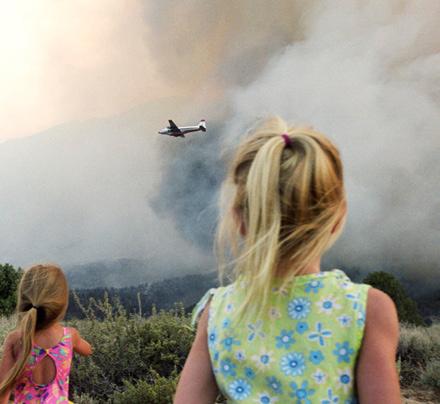

Lifeline 13 11 14 Australian Red Cross 1300 554 419 Salvation Army 1300 371 288 St. Vincent de Paul 1300 633 343 Adventist Development and Relief Agency Australia Ltd 1800 242 372 RSPCA 1300 ANIMAL (1300 264 625) St John Ambulance 1300 ST JOHN (1300 785 646 )
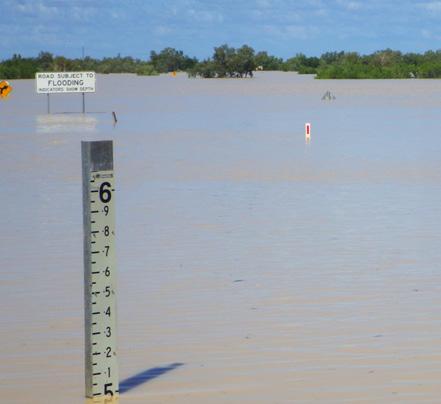
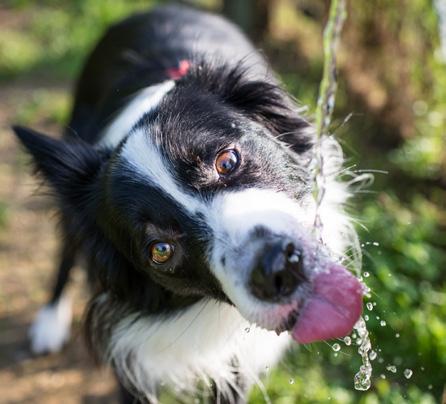
Contact your local council for additional options.
If you are a business owner, information is available at: www.business.qld.gov.au/business/running/disaster-resilence-and-recovery.
Emergency - Police, Fire, Ambulance Triple Zero (000)
Flood and Storm Emergency Assistance (SES) 132 500 Poisons Information 131 126
Crime Stoppers 1800 333 000 Energex - Power Outages 136 262 General Inquiries 13 QGOV (13 74 68) Health and Hospital Information 13 HEALTH (13 432 584) National Relay Services 133 677 - TTY/Voice Calls 1300 555 727 - speak and listen 0423 677 767 - SMS relay

PoliceLink - General Inquiries 131 444 Road traffic and travel information 131 940
Telecommunication faults and damage 132 203 - Telstra Tenants Queensland Advice Service (free call) 1300 744 263